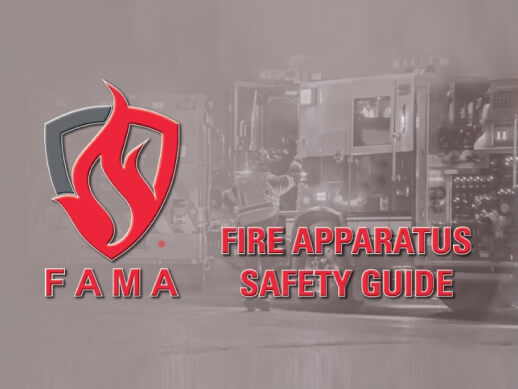Every year, thousands of fire department apparatus specifications are reviewed by Fire Apparatus Manufacturer’s Association (FAMA) member companies before they are used to produce fire apparatus. While items such as tire ratings, engine size, seating requirements, hose carrying capacities, etc., are often defined in minute detail, the working area of the apparatus (the pump operator’s panel) can often be given little attention.
Apparatus specifications should include pump panel material, panel layout, and service accessibility that will ensure the final product is simple to use, uncluttered, and offer trouble-free operation for the pump engineer. In this article we will discuss the importance of the pump operator panel and the considerations that can be explored during the specification process.
PUMP PANEL MATERIAL
While it is true that some departments require their panel material to meet certain specifications, others leave the specification open to interpretation by the OEM bidding the apparatus. Many manufactures use 14-gauge stainless steel (5/64-inch-thick) panels as their default panel with options to use 12-gauge (7/64-inch-thick) panels to increase rigidity. Stainless panels have superior corrosive resistance and offer high strength in a relatively thin package. In addition, many fire service panel items are designed to be used on the relatively thin stainless panels, so manufactures can easily install most panel products.
Coated aluminum or stainless panels are also offered as options for the specifier. The coated panels can be finished with a vinyl coating, painted, or powder coated. Coated panels offer a nonglare surface when compared to stainless panels, but the additional thickness can force apparatus manufactures to modify components to fit without interference. Historically vinyl-covered panels were the coating of choice, but the use of powder-coated panels is on the rise. This change is mainly because of the special trim needed to ensure vinyl-coated panels do not peel. When correct surface treatment is used, the powder-coated panels offer a more rugged solution.
Pump panel material has evolved over the years, and the newest material is a biproduct of aftermarket parts for the passenger truck industry. Spray-on bedliner is being used by nearly all apparatus manufacturers to coat panels at the request of their customers. Spray-on bedliner not only offers a nonglare surface but adds superior chemical and abrasion resistance. The bedliner material makes the panels more rigid, but this comes at the expense of making the panels thicker. Every layer of bedliner material adds roughly a 1/16 inch to the panel thickness and can cause holes in the panel to close. The change in dimension could force the apparatus manufacturer to modify panel components that were designed for thinner panels. Additionally, because of the holes closing, the manufacturer must make the hole larger when the panel is cut to account for this new thickness. Once the panel is complete, care needs to be taken when drilling new holes since once spray-on bedliner begins to peel, it is easy to remove the material.
PUMP PANEL LAYOUT
Your apparatus engineers may have developed pump panel layouts where function and practicality have been balanced to provide an optimum design with a certain combination of gauges, controls, inlets, and outlets. However, if your specification does not conform to their standard selections, the panel layout can get confused in a hurry. Following are some tips to consider when working with your apparatus representative.
- Avoid specifying items that will hardly, if ever, be used. Unused items on the pump panel cause distractions and lessen the effectiveness of the operator.
- Never locate electronic displays or other fragile components next to inlets or outlets. This will prevent an errant hammer used to remove a steamer cap from damaging your equipment.
- Locate items that provide feedback at eye level, such as governors, tank level gauges, foam controller, etc. This will help your pump engineer stay focused during the confusion of a fire scene.
- Items such as tank level gauges should be located close to the control, so engineers do not have to search the panel when refilling the tank.
- Some electronic valve controls include a digital display so analog gauges don’t need to be added, freeing up valuable panel space. Eliminating the gauges can help create panel layouts that are uncluttered, intuitive, and easy to use.
- When specifying panel layout, the specifier needs to be aware of National Fire Protection (NFPA) guidelines, their standard operating procedures, and ensure items are in a thoughtful location.
- Place the gauges and controls for the same function close to each other. This is mandated by the NFPA and is a good way to simplify the pump operator’s job.
- Make sure your panel meets NFPA requirements by locating the governor controls between 42 and 72 inches from the ground. No control should be higher than the 72-inch maximum.
Careful consideration during the design phase of your apparatus will avoid costly rework during final inspection and lead to a much more functional tool for your pump engineer.
SERVICE ACCESS
Never forget your mechanic. While panel options do create logistical problems for the apparatus manufacturer, they also create crowded pump houses. This crowding causes issues for maintenance personnel when valve seals need to be changed, relief valve maintained, or a leaking item needs to be repaired. It is good practice to ask for panels that allow accessibility to panel-mounted valves and any internal intake valves for regularly maintained items. As a minimum, the apparatus manufacturer must provide one opening, with no dimension less than 18 inches, that does not need tools to open. In most cases, this access panel is on the officer’s side of the truck. Consider specifying an access panel on the operator’s pump panel as well to ensure that maintenance personnel have easy access to both sides of the apparatus. Many apparatus committees include a mechanic on the team so he can influence the design.
The pump panel is not only used to house controls but is used to access the pump house for regular maintenance. After the apparatus is delivered is the wrong time to realize that options have driven the panel and pump compartment to be cluttered, confusing to operate, and difficult to repair. Think through the considerations outlined in this article and, most importantly, engage with your FAMA member company early in the process. Work together during the specification stage to ensure that your apparatus is as functional and maintainable as possible. Panel material, panel layout, and pump compartment access are all essential considerations in the specification of your apparatus. Reviewing all three of these factors ensures the specifier will be happy with his new apparatus for years to come.
FAMA is committed to the manufacture and sale of safe, efficient emergency response vehicles and equipment. FAMA urges fire departments to evaluate the full range of safety features offered by its member companies.






